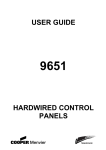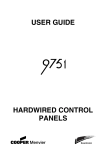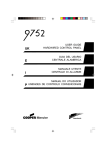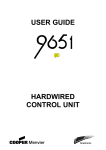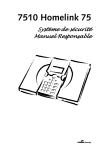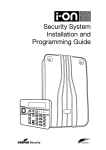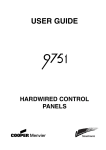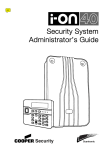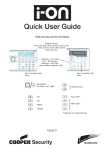Download Scantronic 808 User guide
Transcript
Security System
User Guide
Contents
1. Introduction .................................................... 1
Controls and Displays.......................................... 3
Displays......................................................... 3
Controls:........................................................ 4
2. Everyday Operation ......................................... 5
Access to the System .......................................... 5
Entering and Leaving the Protected Area ............ 5
Setting.............................................................. 6
Full Set .......................................................... 6
Quick Set ....................................................... 8
Part Set ......................................................... 8
If the System Will Not Set ................................ 9
Setting With a Remote control......................... 10
Unsetting ........................................................ 11
Unsetting With a Remote control ..................... 11
3. Alarms........................................................... 12
Types of Alarm ................................................. 12
Silencing an Alarm ............................................ 13
4. Alerts (or Why is it Beeping?) ....................... 14
5. Administration............................................... 15
Entering the Menu ............................................ 15
Omit Zones...................................................... 16
Users .............................................................. 16
Editing Existing Users .................................... 16
Adding Users ................................................ 22
Deleting Users .............................................. 23
View Log ......................................................... 24
Test................................................................ 24
System Configuration ........................................ 26
Facilities On/Off ............................................ 26
Set Date and Time ........................................ 27
Loudspeaker................................................. 27
Speech Phone Book ....................................... 28
List of Menu Options ......................................... 29
Page ii
1. Introduction
The i-on16 is a wireless intruder alarm system intended mainly
for use in domestic and small commercial properties.
The heart of the i-on16 system is the control unit and its keypad.
The control unit contains the main wireless receiver, the power
supply and stand-by battery. The stand-by battery can keep the
alarm system going for up to 12 hours if the mains supply fails.
Connected to the control unit by cable is a keypad. The keypad
has a two line display to show you status information, and various
keys for operating the system. The keypad also contains a
speaker to give warning tones when the system is setting or
unsetting.
Users identify themselves to the system by keying in access
codes. If they do not wish to use access codes then the keypad
also contains a proximity tag reader, allowing users to identify
themselves by means of small electronic tags that they carry with
them.
To protect an area the control unit can operate a range of
detectors, each containing a small radio transmitter that
communicates back to the control unit. Figure 1 shows some
examples. In addition to fixed detectors the control unit can also
monitor small portable transmitters that users can employ to
start alarms remotely, for example in the case of a panic alarm.
When the control unit detects an alarm, it can start an external
sounder/strobe unit by sending the appropriate radio signal. In
addition the control unit can also communicate over the public
switched telephone network (PSTN) using a plug on module. The
module also provides speech recording and playback facilities so
that the system can send recorded speech messages to preprogrammed telephone numbers.
The control unit also provides sets of connectors for four outputs.
If necessary the installer can use these connectors to link the
control unit to siren/strobe units or other equipment.
Page 1
Introduction
A
B
1. Two button panic alarm.
2. Two button panic alarm with tilt
switch.
3. Two button panic alarm
A
1
2 abc
3 def
B
4 ghi
5 jkl
6 mno
C
7 pqrs
8 tuv
9 wxyz
D
*
0
#
4. Four button remote control.
5. Wireless arming station.
6. Door Contact/Universal Transmitter.
7. Smoke Detector.
8. Passive Infra Red.
9. External siren/strobe.
Figure 1. i-on16 Peripherals
A complete i-on16 system comprises a control unit and up to:
16 fixed wireless alarm detectors
One external siren/strobe unit
16 portable four button remote controls
16 portable panic alarm buttons
16 users.
Page 2
Introduction
This rest of this guide shows the simple procedures required to
operate and administer the system. For information on installing
the i-on16 please read i-on16 Installation and Programming
Guide. Each of the radio peripherals also have their own guides.
Controls and Displays
Figure 2 shows the controls and displays available on the keypad.
1
2
7
3
4
5
1.
2.
3.
4.
LCD display .
Programming keys.
Navigation key
Setting and unsetting keys.
A
1
2 abc
3 def
B
4 ghi
5 jkl
6 mno
C
7 pqrs
8 tuv
9 wxyz
D
*
0
#
6
5. Personal Alarm (PA) keys.
6. Alpha/numeric keys.
7. Set/Unset status LEDs.
Figure 2. Controls and Displays
Displays
The LCD display shows messages and prompts to help guide you
through setting, unsetting, resetting and programming the
system.
When the system is idle (either while
set or unset) the display shows the
“standby screen”, comprising the time
and date:
I-ON16
11:15 20/3/08
To draw your attention to special events the rim of the navigation
key glows red.
Page 3
Introduction
The four LEDs on the right of the programming keys show you
that the system is set or unset. The left hand LED glows when the
system is full set, the second from left glows when the system is
part set. Note that the installer can disable these LEDs in order to
hide the state of the system. (The two right hand LEDs are never
used.)
Controls:
A
Full sets the system.
B
Part sets the system.
Unsets the system.
u
In menus: scroll up. In text editing: move cursor left
n
In menus: scroll down. In text editing: move cursor right.
>
If the bottom line of the display shows a “>” at the right,
pressing this key selects the submenu named on that line.
If the bottom line of the display shows “On” “Off” “yes”
“no” “I” (for include) “O” (for omit) then pressing this key
changes the value to its opposite.
<
Deletes characters when editing names.
Y
Press this key to confirm a decision.
X
a) Moves the display to a higher level of the menu.
b) Press this key to abandon your decision when the
display shows “Are you sure Y/N?”
Press this key to gain access to the programming menus.
1 to 0, Used when keying in user codes and telephone numbers.
*, # Can also be used to key in text for names.
#
When keying in text press # to change between capitals
or small letters.
Press these keys to start a PA alarm. (Press both at the
same time.)
Page 4
2. Everyday Operation
Everyday operation involves setting and unsetting the alarm
system and occasionally dealing with alarms. If you need to know
how to set up new users, or change the way the system operates
then please read the “Administration” section.
Access to the System
To operate the system a user must identify themselves, either by
entering an access code on the keypad or by presenting a
proximity tag to the front of the keypad.
Access code and tag act as unique identifiers for each user, and
may be used interchangeably at any time.
When delivered from the factory the control unit recognises just
one user, and this user has Administrator privileges (see page
15). This user’s default access code is “1234”, and they do not
have any tag or other device registered to their account.
Cooper Security Limited recommend that you change the
default access code as soon as possible (see page 16).
The installer has a separate access code which they cannot use to
set or unset the alarm system. Neither can they use that code to
change details of other users registered to the system. Similarly,
the Administrator code has no access to any installer
programming menus.
Entering and Leaving the Protected Area
In many alarm systems the keypad is inside the protected area.
To make sure that you can get to the keypad when the system is
set without starting an alarm the installer programs the control
unit to pause for a few moment if it detects activity on specific
entry/exit routes. The installer chooses the length of the pause to
enable you to get to the keypad if you are entering, or leave the
protected area if you are setting the system. During the pause
the keypad will give a warning tone. When you hear the warning
tone do not stray off the entry/exit route chosen by the installer
or you will start an alarm.
Page 5
Everyday Operation
Setting
Note: Whenever you set the system you should first make sure
that all doors and windows are secure.
Full Set
Make sure the system is idle.
1.
EITHER: Key in your access
code.
OR Present a proximity tag to the
keypad.
The display shows:
A : Full Set
B : Part Set
(The names for A and B may
differ from that shown,
depending on how the installer
has set the system up.)
2.
Press A.
The display shows the number
of seconds you have to left in
which to leave the premises.
The keypad gives the exit
warning tone:
A continuous tone means the
system can set normally.
An interrupted tone means
that your exit door is open.
See Note b) on next page.
3.
Leave by the exit door and
make sure it is closed
properly.
Page 6
Setting
10 to set
Everyday Operation
At the end of the exit time the
exit warning tone stops and
you should hear a double
“beep” confirmation tone to let
you know that the system is
set.
The display shows the
message "System Set" for a
few seconds, followed by the
standby screen. The left hand
LED glows to show that the
system is full set.
System Set
Notes:
a) If you decide you want to stop setting then press .
b) Your system may be programmed to set silently. If so,
there will be no exit warning tone as the system sets.
c) If your system is full set you cannot go directly to part
set. You must unset the system first.
d) If your system is part set, then you cannot go directly to
full set. You must unset the system first.
Page 7
Everyday Operation
Quick Set
Quick Setting does not require the use of an access code or tag.
(The Installer must enable this facility for you.)
Make sure the system is idle.
1.
Press A.
The keypad gives the exit
warning tone.
2.
Setting
10 to set
Leave by the exit door and
make sure it is closed
properly.
At the end of the exit time the
display shows the message
"System Set" for a few
seconds.
System set
While the system is set the
display shows the standby
screen.
Note:
If you decide you want to stop setting then press
.
Part Set
When programming your system, the installer can mark some of
the zones “Part Set”. If, when setting the system, you press B
instead of A then the control unit sets the zones selected by the
installer, and none of the others. This feature is designed so that
you can protect, for example, the perimeter of your house while
you remain inside it, or the downstairs rooms while you are
asleep upstairs.
Page 8
Everyday Operation
If the System Will Not Set
Normally, the system will set only when all the detectors are
“quiet”, that is: not reporting any activity. (This does not apply to
those detectors on your exit door or exit/entry route. The system
expects these detectors to be active as you leave the protected
area.)
If you try to set when one or more detectors are still active then
the display shows the words “SETTING FAULTS” and which zones
are active.
You can make the system “omit” those active zones, either while
you are setting the system (see below) or beforehand (see page
16 for instructions on how to omit zones before setting the
system).
1.
Follow the instructions on page
6 to set the whole system.
If any detectors are not yet
ready to be set then the
display shows, for example:
2.
SETTING FAULTS
Z02 A Back Door
EITHER Press Y to carry on
setting.
The system sets with the
active zones omitted.
OR Stop the setting process by
pressing X.
Page 9
Everyday Operation
Setting With a Remote control
Note: You must program the control unit to recognise ("learn") a
remote control, see page 23.
Secure all your windows and doors.
Make sure the system is idle, and that you can hear the warning
tones from the keypad.
1.
Press the appropriate button on the remote control, either
full set (A) or part set (B), see page 20.
The keypad sounds the exit warning tone.
2.
Leave by the exit door and make sure it is closed properly (if
you have not already done so).
At the end of the exit time the warning tone stops you should
hear a double “beep” confirmation tone. The display shows
the message "System Set" for a few seconds. The installer
may also have programmed your external sounder/strobe to
flash briefly.
While the system is set the display shows the standby screen
and the left hand LED glows.
If The System Will Not Set
If one of the detectors is still active when you try to set the
system then you will not hear the exit warning tone.
What happens next depends on how the installer has set up your
system.
a) Try pressing A once more on your remote control. If the
installer has programmed the system to do so then it will carry on
and set, omitting the active detector.
b) If the system will not set on the second press of button A then
you will have to go to the keypad and set the system from there.
Page 10
Everyday Operation
Unsetting
When unsetting the system do not stray from the entry route
designated by the installer. If you do then you will cause an
alarm.
1.
Enter by the designated entry
door.
The control unit starts the
entry tone.
2.
EITHER Key in your access
code.
OR Present a prox tag to the
keypad.
The system unsets.
The display shows:
System Unset
Followed by the standby
screen.
Unsetting With a Remote control
1.
Enter by the designated entry door.
2.
Press
on your remote control.
The system unsets. At this point the system displays the standby
screen.
Page 11
3. Alarms
Types of Alarm
The i-on16 normally starts an alarm when it receives an alarm
signal from one of its detectors. In addition, you can start a panic
alarm from the keypad. The table below shows the different kinds
of alarms possible.
Type of
Alarm
Intruder
Signal
(see note)
Started by:
Loud
warbling tone
from siren.
Normal alarm or entry route zone
activated when system is set.
Fire
Repeated
“Dee Dah”
from siren.
Fire zone activated at any time.
Panic
Loud
warbling tone
from siren
PA zone or Panic Alarm transmitter
activated at any time.
24 hour zone activated at any time.
Pressed on keypad.
(The installer must enable this
feature on your system.)
Technical
Loud
warbling tone
from siren.
Technical alarm zone activated at
any time.
Note: As well as making an audible signal, the installer can
program the i-on16 to send pre-recorded voice messages
over the telephone network. These messages can go to a
person nominated to monitor alarm calls. Ask your installer
for more details.
Page 12
Alarms
Silencing an Alarm
In an alarm the i-on16 operates the siren. The siren runs for a
limited time set by the installer (a maximum 15 minutes for
intruder and PA alarms).
If you return to the control unit after the siren has stopped and
key in your access code then the red LEDs around the navigation
keys glow to tell you that an alarm has occurred. Press > to see
information about the alarm. (Press u or n to see the name of
the zone.) Press Y to restore the display to normal.
If you return to the system while the siren is running you can
silence the siren as follows:
1.
Key in your access code.
The siren stops and the screen
shows the first zone to cause
the alarm, for example:
Reset Required
Burg Z03 Alarm
(Press u or n to see the
name of the zone.)
2.
Press y.
The display returns to normal.
If you wish to see any other zones that were triggered during the
alarm, look in the log (see page 24).
Page 13
4. Alerts (or Why is it Beeping?)
From time to time the control unit may detect that there is a
problem with the system. It will try to inform you of this by
starting an alert. During an alert the rim of the navigation pad
glows red, and the keypad will give an short “beep” every few
minutes.
To see the cause of the alert:
1.
Make sure the system is unset and that the keypad display
shows the standby screen.
2.
Press Y .
The display asks you to key in an access code.
3.
Key in a user access code.
The bottom line of the display shows a message describing
the most recent active alert.
4.
Either:
Press Y to acknowledge that you have read the alert.
If you press u or n then the system will show you any other
alerts that may be active. If there are no other alerts the rim
of the navigation pad will glow green and the keypad will
return to its’ standby screen. In addition the keypad will stop
beeping.
If you press X then the rim of the navigation pad will stay red
and the system will show the text of the alert the next time
you key in an access code.
Note: 1. The system will not alert you to short interruptions of
mains power. If the cause of an alert goes away, then the
system will remove the Alert message.
2. The system records all alerts in the log, with the time
when you acknowledged them.
Page 14
5. Administration
To make changes to the way your system works you must enter
the Menu. Your degree of access to the Menu depends on what
type of user you are: Admin User or Normal User. An Admin User
has access to all the options of the Menu. A Normal User:
Can change their own access code.
Cannot add or delete other users.
Can turn the Chime feature on or off.
Entering the Menu
1.
Make sure the display shows the standby screen.
2.
Press
3.
Key in an access code.
.
The display shows the first item in a list of options. (See
page 29 for a complete list of options.)
4.
Press u or n to scroll through the options available, followed
by > to gain access to an option.
5.
Press Y to confirm an option when you have finished making
changes.
6.
Press X (if necessary several times) to leave the Menu.
The rest of this chapter describes each of the main options in the
Menu.
Page 15
Administration
Omit Zones
You may wish to prevent a zone causing an alarm. For example, if
you have a fire door that is normally closed and protected by a
detector you may wish to leave it open for fresh air or to move
goods in and out. To do this the control unit allows you to "Omit"
a zone.
1.
Enter the Menu and select Omit Zones.
The bottom line of the display shows the first of a list of
zones.
2.
Press u or n to display the zone you wish to omit.
3.
Press > to mark the zone for omission.
The character at the end of the line changes to an "O" to
show that the zone will be Omitted.
If you change your mind then press > again so that the end
of the line shows an "I" (for Included).
4.
Repeat steps 2 and 3 for any other zone you wish to omit (or
include).
5.
Press Y to store the changes you have made.
The control unit allows you to omit a zone for one
setting/unsetting cycle. You will have to omit the zone again for
the next setting/unsetting cycle.
Users
The control unit can recognise up to 16 individual users. Select
Users in the Menu to add new users, change their details, or to
delete them from the system.
Editing Existing Users
If you wish to change the details for an existing user then:
1.
Enter the Menu and select Users - Edit User.
The bottom line of the display shows the first in a list of the
users already programmed into the control unit.
Page 16
Administration
2.
Press u or n to display the user you wish to edit, and then
press >.
The bottom line shows one of a list of the options that you
can edit:
Name
Type
Code
Prox Tag
Remotes
Panic Alarm
Use the u or n keys to scroll through the list.
3.
Press > to select the option you wish to edit.
(The options available are the same as those shown when
adding a user.)
4.
Press Y when you have finished.
Name
If you wish to edit the name displayed on the keypad for a user:
1.
Select Users - Edit User - User(nn) - Name.
The display shows the current name given to the user, and
places a cursor at the end of the name.
2.
Key in the name from the keypad. Press each key one or
more times to obtain the letter you want (the letters of the
alphabet appear on the keys in the same arrangement as on
many mobile phones, see Figure 3.)
3.
Press u to move the cursor left, or n to move the cursor to
the right.
4.
Press < to remove letters to the left of the cursor. Press >
to insert a space.
Page 17
Administration
1
4 ghi
2 abc
3 def
ABCÆÅÄ
DEF
5 jkl
6 mno
GHI
JKL
MNOØÖ
7 pqrs
8 tuv
9 wxyz
PQRS
TUV
*
0
WXYZ
#
Space'():.-!&@0
Figure 3. Letters Assigned to Keys
5.
Press # to change between capitals and small letters.
The cursor becomes an underline when you type in small
letters and a block when you type in capitals.
6.
Press Y when finished.
User Types
To change a user’s type select Users - Edit User - User(nn) - Type.
1.
Press u or n to change between Admin User and Normal
User.
2.
Press > to select the user type you wish to assign to the user.
See page 15 for a brief explanation of Administrator and Normal
User.
Access Code
To change a user’s access code, select Users - Edit User - User(nn) Code.
1.
Key in an access code for the user.
When you press the last digit of the access code the display
asks you to key in the same access code again.
2.
Key in the same digits again, in the same order.
Access codes are four digits long.
Page 18
Administration
Proximity Tags
A proximity tag is a small plastic token with a low powered radio
transmitter inside. Each tag contains a unique identity code.
Inside the keypad is a sensor. When you present the tag within
about 10mm of the front of the keypad, the control unit senses
the presence of the tag and reads its identity code.
If a user presents a tag that the control unit recognises then the
control unit allows the user to access the system in the same way
as if they had keyed in a recognised access code.
To allocate a tag to a user, select Users - Edit User - User(nn) - Prox
Tag.
Note: If the user already has a prox tag allocated to them then
the screen will display “Delete Prox Tag?”. See page 21.
The display asks you to present a tag to the front of the
keypad.
1.
Hold the tag up close to the front of the keypad.
The control unit learns the identity of the tag.
You cannot register more than one tag per user. If you
present a tag that the control unit has already registered to
another user then you will hear a single low tone, the display
will tell that the tag is already in use and will then revert to
asking you to present the tag.
If you do not wish to register a tag for the user then press X.
If you have a proximity tag and want to know who it belongs to
then use the Test - Proximity Tag menu option, see page 24 .
Page 19
Administration
Remote controls
A remote control is a transmitter that you can attach to a keyring.
The remote control has four buttons and a small LED that glows
when it transmits a signal. When delivered from the factory three
of the buttons are dedicated to setting or unsetting the system
(see Figure 4).
1.
2.
3.
4.
5.
Full Set.
Part Set.
Not used.
Unset.
Transmit LED.
A
B
Figure 4. Remote control Buttons.
You may allocate one (and only one) remote control to each user.
To allocate a remote control to a user, select Users - Edit User User(nn) - Remotes.
Note: If the user already has a remote control allocated to them
then the screen will display “Delete Remote?”. See page
21.
The display asks you to press one of the buttons on the remote
control.
1.
Press any button on the remote control that you wish to
register.
When you press the button the control unit learns the
identity of the remote control and registers it to the user.
If you do not wish to register a remote control press X.
Page 20
Administration
If the control unit has already learned that remote control then
you will hear a low tone and the display tells you that the remote
control is already in use.
If you have a remote control and want to know who it belongs to
then use the Test - Remotes menu option, see page 24 .
PA (Panic Alarms)
A PA is a two button transmitter, used to start a Panic Alarm. To
activate the transmitter you must press both buttons at the same
time. On some models a third button acts as a lock so that you
can prevent the PA going off when carrying it in your pocket.
Note: While you are registering a new PA the control unit will not
respond to an alarm signal from any PA it has already
learned.
To allocate a panic alarm to a user, select Users - Edit User - User(nn)
- Panic Alarm.
Note: If the user already has a PA allocated to them then the
screen will display “Delete PA?”. See “Deleting Remote
Controls, Tags and PAs” below.
The display asks you to press both buttons on the PA.
1.
Squeeze both buttons on the PA.
When you squeeze the buttons the control unit learns the
identity of the PA and registers it to the user.
If you do not wish to register a PA press X.
You cannot register more than one PA per user. If the control unit
has already learned that PA then you will hear a low tone and the
display remains unchanged, asking you to press the buttons on
the PA.
If you have a PA and want to know who it belongs to then use the
Test - Panic Alarms menu option, see page 24 .
Deleting Remote Controls, Tags and PAs
If a user has lost a remote control, prox tag or panic alarm then
you should delete it from the system to make sure that no
unauthorised person can use it. Also, if you wish to reassign a
device to another user, you must first delete it from the system.
Page 21
Administration
1.
Enter the Menu and select Users - Edit User.
The bottom line of the display shows the first in a list of the
users currently recognised by the system.
2.
Press u or n to display the user whose device you wish to
delete., the press >.
The bottom line of the display shows “Name”.
3.
Press u or n until the bottom line shows the device you wish
to delete, then press >.
If the user you selected in step 2 has a device registered to
them then the display asks if you wish to delete it, for
example: “Delete Panic Alarm?”.
4.
Press Y.
The display shows, for example, “Panic Alarm Deleted”.
To register a device with the user, re-enter the Menu and select
Users - Edit User. Select the user and then the device type you wish
to add.
Adding Users
When adding a new user you can also allocate them proximity
tags, remote controls and panic alarm transmitters. If you do not
wish to do so at that point then you can assign them later by
using the Edit Menu option.
To add a new user:
1.
Enter the Menu and select Users - Add User.
The display shows a default user name, for example: “User
04”. Edit the name as described on page 17,
2.
Press Y when you have finished editing the name.
The display shows the default type for a new user (Normal
User, see page 15 for a description of user types).
3.
Select the type you want to assign to the new user and press
Y.
The display asks you to assign a new user code.
Page 22
Administration
4.
Key in the user code you want the new user to employ. Key
it in a second time when prompted by the display.
The display asks you to present a proximity tag to the
keypad.
5.
Present an unused tag to the keypad. If you do not want to
assign one to the user press Y.
The display then asks you to press a button on any remote
control that you want to assign to the user.
6.
Press a button on a remote control (one that is not currently
registered to any other user). If you do not have one press
Y.
The display finally asks you to press both buttons on any PA
that you want to assign to the new user.
7.
Press both buttons on a PA that you wish to assign to the
user. If you do not have one for the user press Y.
The display should now tell you that the new user has been
added to the system.
Deleting Users
To remove a user from the system:
1.
Enter the Menu and select Users - Delete User.
The bottom line of the display shows the first user in a list of
the users recognised by the system.
2.
Press u or n until the display shows the user you want to
delete.
3.
Press >.
The display shows the message “Delete All Details”.
(If you change your mind at this point press X.)
4.
Press Y .
The control unit deletes the user from the system.
Once you delete a user, the system does not respond to their
access code or to their proximity tag. In addition, the control unit
Page 23
Administration
"forgets" the identity of all remote controls and PAs registered to
the user.
View Log
The control unit keeps a log of the last 250 events (for example,
alarms and setting/unsetting). To read the log:
1.
Enter the menu and select View Log.
The display shows you the most recent log event.
2.
Press u or n to scroll through the log.
n shows earlier events, u shows more recent events.
3.
Press > to see a more detailed description of the event.
4.
Press X to finish viewing the log.
Test
If you think that your system is not working correctly then you
can use the Test option to test various peripherals. If the test
confirms that part of the system is not working then contact your
installer.
The Test option also lets you check the identity of Remote
controls, Panic Alarms and Tags.
To start testing, make sure the system is idle then:
1.
Enter the Menu and select Test.
The display shows the Test menu.
2.
Select the part of the system that you wish to test.
3.
Press X to stop the test.
You can test each part listed in the Test menu as follows:
Page 24
Administration
Siren
Press > to turn the siren on and off again. The
word "On" or "Off" on the display shows whether
you should be hearing the siren.
Keypad
Press each key once. The display shows a
character in response. Press both PA keys
together to test. Press X to end the test.
Walk test
The display shows a list of all the detectors
installed on the system. The top line of the
display shows you how many detectors remain
to be tested. Walk round and trigger each
detector. Every time you trigger a detector the
control unit gives a double tone and the display
shows an "A" at the end of the line for that
detector. Note that you cannot test 24 hour or
fire zones.
Remotes
Press any button on the remote control. The
display shows the identity and user of the
remote control, and the button that the control
unit believes you pressed. Press all the buttons
on the remote control in turn.
Panic Alarms
Press both buttons on the panic alarm
transmitter. The display shows the identity of
the user assigned to the panic alarm.
Proximity Tags
Present the tag to the front of the keypad. The
display shows the user assigned to the tag.
Page 25
Administration
System Configuration
The System Configuration option allows you to set up parts of the
system to suit your particular needs. If you need more extensive
changes to the operation of the system then you must contact
your installer.
Make sure the system is idle.
1.
Enter the Menu and select System Config.
The bottom line of the display shows the first item of the
System Configuration menu.
2.
Press u or n to scroll through the options available, followed
by > to gain access to an option.
Facilities On/Off
Chime
The installer may have set up your alarm system to give a chime
tone whenever something triggers one or more detectors while
the system is unset. If you wish to switch this feature off (or on)
then:
1.
Enter the System Config menu and select Chime.
The bottom line of the display shows the current state of the
chime feature, for example “Chime On” if chime is currently
working.
2.
Press > till the bottom line of the display shows the status
you want (for example “Chime Off” if you want to silence the
chime feature).
3.
Press Y to leave the option when you have finished making
changes.
Page 26
Administration
Set Date and Time
You will need to re-program the date and time if the control unit
looses power for an extended time, and the battery is exhausted.
1.
Enter the System Config menu and select Set Time/Date.
The top line of the display shows “Set the date” and the
bottom line shows the current date in number format
(day/month/year). The day is highlighted.
2.
Key in the digits for the day/month/year. Press Y when you
have finished.
The top line of the display shows “Set the time” and the
bottom line of the display shows the current time in 24 hour
numerical format (hours: minutes). The hours are
highlighted.
3.
Key in the hours and minutes. Press Y to finish.
Note: The internal clock does not change for daylight saving.
Loudspeaker
You can make the tones from the internal loudspeaker louder or
softer:
1.
Enter the Menu and select
System Config - Loudspeaker.
The top line of the display
shows “Loudspeaker” and the
bottom line of the display
shows a row of stars.
2.
]
Press > to increase the volume
or < to decrease the volume.
The loudspeaker volume
changes and the display shows
the change by increasing or
decreasing the number of
stars, for example:
3.
Loudspeaker
[****
Loudspeaker
[**********]
Press Y to finish.
Page 27
Administration
Note: Do not make the loudspeaker so quiet that you cannot hear
the exit warning tone.
Speech Phone Book
Note: This option appears only if you have the I-SD01 speech
dialler fitted.
If you need to re-direct speech messages to new telephone
numbers then:
1.
Enter the Menu and select System Config - Speech Phone Book.
The bottom line of the display shows “Tel No 1”.
2.
Press u or n to scroll through the available telephone
numbers, followed by > to gain access to an individual
number.
The bottom line of the display shows the current digits of the
telephone number.
3.
Key in the new telephone number from the keypad. If
necessary, press u to move the cursor left, or n to move
the cursor to the right. Press < to remove digits to the left of
the cursor.
4.
Press Y to store the changes you have made.
Page 28
List of Menu Options
Item
Omit Zones
(Zone 01, 02, …)
Users
Edit User
(for each user:)
Name
Type
Code
Prox Tag
Remotes
Panic Alarm
Add User
Delete User
View Log
Test
Siren
Keypad
Walk test
Remotes
Panic Alarms
Prox Tags
System Config
Facilities On/Off
Chime
Set Date & Time
Loudspeaker
Speech Phone Book
Page
16
18
16
17
18
16
19
20
21
22
23
24
24
25
25
25
25
25
25
26
26
27
27
28
Page 29
© Cooper Security Ltd. 2008
Every effort has been made to ensure that the contents of this book are correct.
However, neither the authors nor Cooper Security Limited accept any liability for
loss or damage caused or alleged to be caused directly or indirectly by this book.
The contents of this book are subject to change without notice.
Printed and published in the U.K
Part Number 11847976 Issue 1
Page 30

































